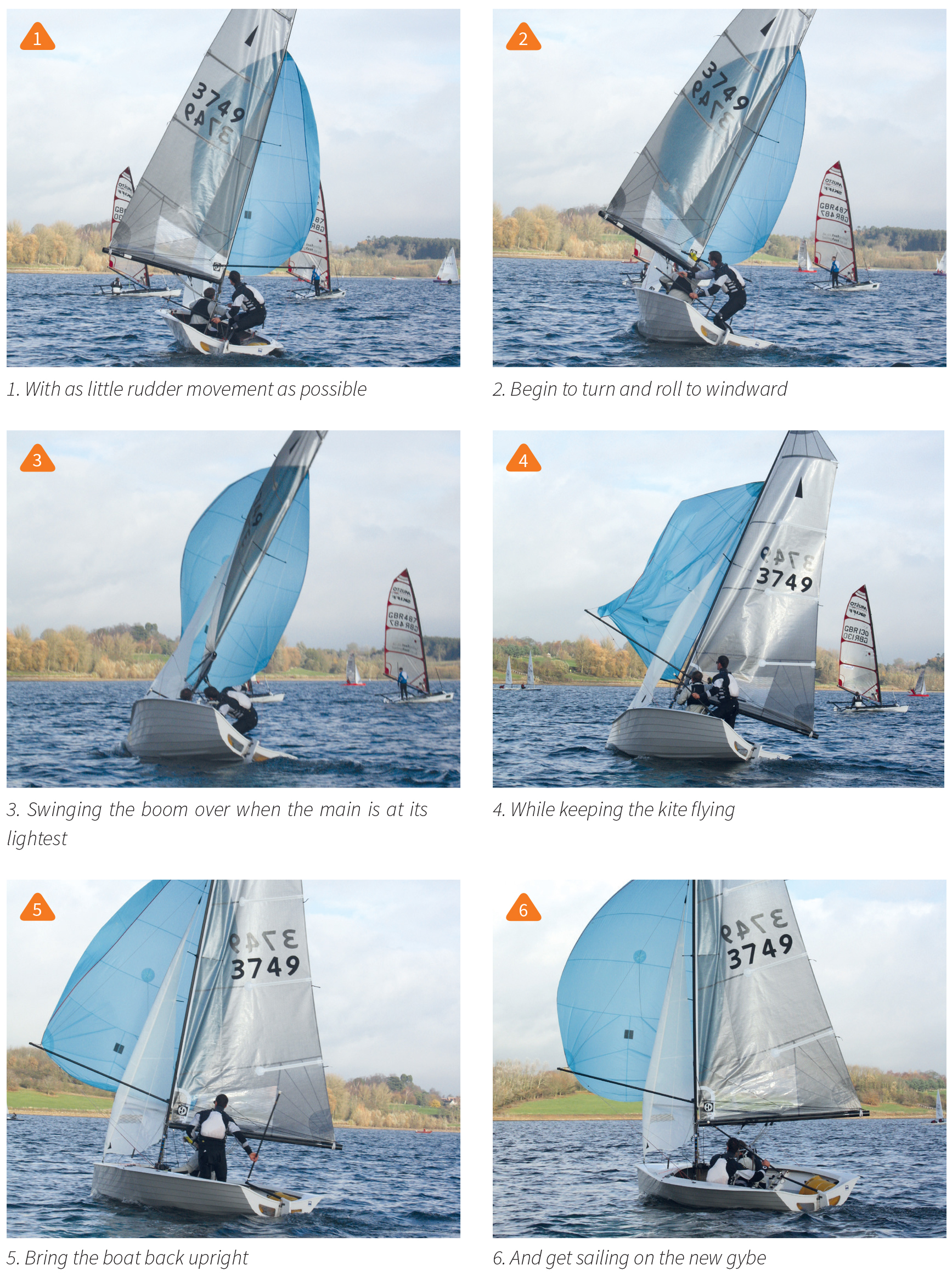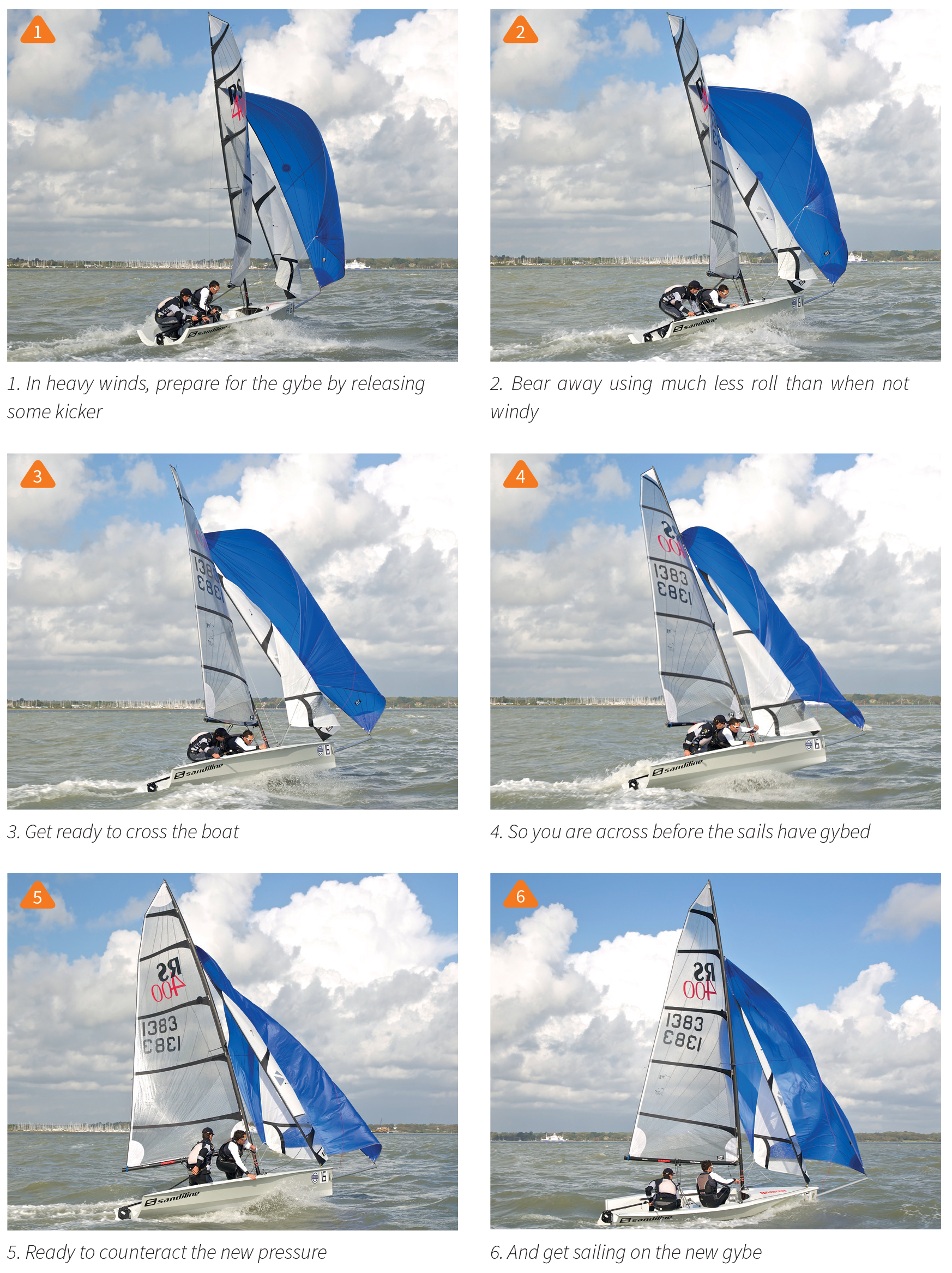Gybing With Nick Craig
Book Extract
HOW TO AVOID THE HANDBRAKE (RUDDER)
Changing direction with your rudder is slow. While the rudder is effective for steering, steering drags a piece of wood or carbon through the water at an angle which significantly slows your boat. Over a race, you will steer a huge amount, not just for boat handling manoeuvres but also steering through shifts upwind and waves downwind. So steering effectively makes a huge difference to speed around a race course. Often the fastest sailors are no quicker in a straight line, but they are much more effective at steering.
Boat handling is, in some ways, the easiest area of sailing to perfect because each manoeuvre is repeatable and relatively standard. With sufficient quality practice, your boat handling can be excellent. Pressure testing your boat handling is key. You can do this in training by doing a set number of tacks / gybes / spinnaker hoists / drops on a short course, rather than as leisurely manoeuvres. Doing this against another boat is a good way of seeing who has the better boat handling and learning from each other.
Heel
Steering through heel (windward heel to bear off, leeward to luff) will reduce your rudder use massively. It is worth practising with your tiller elasticated to the middle so that you learn how much heel your boat needs to steer in different conditions. You will need more heel to steer in light winds as your boat has less momentum. Sailing rudderless is widely recommended but changes the balance of your boat, so sailing with the rudder elasticated to the middle is more useful.
Sail Trim
Steer through sail trim in conjunction with heel. If you sheet in your main harder than your jib, you move the centre of effort back in the boat. Your pivot point (centre of your foils) does not change as you do this, so with the centre of effort moving behind your pivot point, your boat will naturally luff itself. If you sheet in your jib harder than your main, the reverse happens. In a single-hander, sheeting in the main also causes the boat to luff and easing it to bear off. But sail trim is more effective at steering with two or more sails working in unison.
LIGHT WINDS
In light winds your boat does not have much momentum. You should move pretty sharply to windward to initiate the turn, to avoid having to use the rudder to do this. You should roll as much as possible, so be just on the edge of shipping water or the boom hitting the water. As you bring the boat upright out of the gybe be careful not to knock the wind out of the sails if the wind is very light. If that does happen, gently ease your sails back out to avoid them backwinding and decelerating you. Again be mindful of Rule 42.

MODERATE WINDS
In moderate winds, the initial movement to turn the boat does not need to be as marked. The sequence of moves is the same as those for light winds, but again with less exaggerated body movement.
WINDY CONDITIONS
You should aim to gybe when your boat is accelerating or at maximum speed as that reduces
the apparent wind so making the gybe easier. Time your gybe for when you are just starting to sail down a wave, or just after a gust has first hit, so that you are accelerating. This also gives you more time to gybe before you potentially decelerate due to sailing into the back of the next wave or the gust running out. This is slightly different to the conventional wisdom of gybing when at maximum speed.
Aim for no roll on the gybe, which often means crossing the boat just before the sails have gybed. Release some kicker before the gybe to depower the mainsail as you exit the gybe. Err towards over- rather than under-steering because, if it doesn’t work out, a leeward capsize is faster to recover from than a windward one. Putting the centreboard down can add stability and also speed recovery from a capsize if all goes wrong!
Swinging the boom to initiate the mainsail going through the gybe can help to prevent the boom moving over very quickly, which makes the boat harder to control. Aim to swing the boom when the main is at its lightest so that the impact of it hitting the new side is least, giving you the best chance of staying dry. Practice will help you know at what point in the gybe the main is at its lightest.
A key point for surviving a windy gybe is your exit angle. Typically there is a safe angle where you won’t capsize to windward as you aren’t too high, nor will you capsize to leeward as you aren’t too low. Learning this angle for your boat comes through practice and focusing on your exit angle as you go through the gybe.
Practice, and a lot of swimming, makes for perfect windy gybes! This is a great thing to practise outside of racing, ideally in more wind than you would normally gybe in during a race, and somewhere warm (Lake Garda is perfect for this, we did a lot of RS400 gybing practice there!). Outside of racing there is no cost to capsizing (other than getting wet!) so you should practise really fast gybes. This will give you a feel for how fast you can steer and move across the boat through gybes before you need to slow them down to stay upright.
If your sailing programme does not allow you the time for practice outside of racing then you should seek to progress your windy gybing on at training events, even if that means capsizing occasionally.

© Not to be reproduced without written permission from Fernhurst Books Limited.